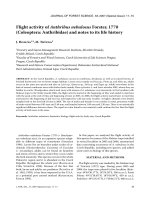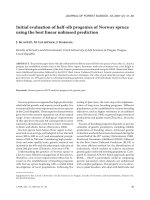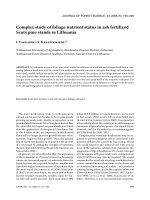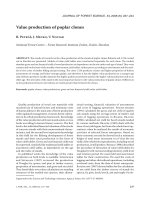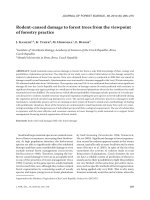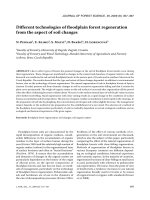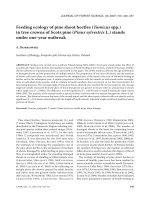Báo cáo lâm nghiệp: "Different technologies of floodplain forest regeneration from the aspect of soil changes" pot
Bạn đang xem bản rút gọn của tài liệu. Xem và tải ngay bản đầy đủ của tài liệu tại đây (449 KB, 11 trang )
J. FOR. SCI., 55, 2009 (8): 357–367 357
JOURNAL OF FOREST SCIENCE, 55, 2009 (8): 357–367
Floodplain forest soils are characterized by the
rapid decomposition of organic residues, consid-
erable differences in the accumulation of organic
residues in the layer of surface humus during the
year (K 1985) and the relatively high content of
organic matter (carbon) in the organomineral layer
of surface horizons and often in “buried horizons”
(P 1976). It means that the accumulation
and dynamics of changes in the organic matter are
particularly dependent on the history of the origin
of alluvial areas, on the species composition of
floodplain forests and, last but not least, on meth-
ods of management, particularly on the technology
of floodplain forest regeneration. Pedunculate oak,
ash and hornbeam are of use in the dynamics of
the rate of decomposition processes (K 1985).
Problems of the effect of various methods of re-
generation on the soil environment are discussed,
which is also the subject of this paper, particularly
comparing the effect of the natural regeneration of
floodplain forests with clear-felling regeneration.
Methods of regeneration of floodplain forests in
various European countries are different depend-
ing on ecological conditions, historical experience
and economic aspects. In the majority of countries,
regeneration by means of clear-felling on small areas
is used, particularly with reference to pedunculate
oak regeneration. Of course, from the point of view
of biodiversity, a tendency increases to use natural
regeneration broadly used in Croatia or by means
of coppice forest or coppice-with-standards (K
et al. 2008).
Different technologies of floodplain forest regeneration
from the aspect of soil changes
N. P
1
, E. K
2
, S. M
1
, D. B
1
, H. L
2
1
Faculty of Forestry, University of Zagreb, Zagreb, Croatia
2
Faculty of Forestry and Wood Technology, Mendel University of Agriculture and Forestry
in Brno, Brno, Czech Republic
ABSTRACT: Like in other types of forests the greatest changes in the soil of floodplain forest stands occur during
their regeneration. ese changes are manifested as changes in the content and dynamics of organic matter in the soil.
Research was conducted in oak and ash floodplain forests in the eastern part of Croatia and in southern Moravia in the
Czech Republic. e results showed that the type and extent of these changes depended, in addition to environmental
factors, also on the technology of forest regeneration. e natural regeneration of oak in floodplain forests of Spačva
(eastern Croatia) protects soil from dramatic changes in soil by successive regeneration felling and that it retains the
plant cover permanently. e weight of organic matter on the soil surface is increased after regeneration till the period
when the effect of thinning becomes evident (about 70 years). In the surface mineral layer of soil the pH value increases
after shelterwood felling. Stand regeneration with clear-cutting results in a rapid change in the conditions of surface
humus accumulation and decomposition. e process of organic residue accumulation is interrupted in the clearings. In
the preparation of soil/site by ploughing, the concentrations of nitrogen and carbon slightly decrease. e management
impact depends on the method of site preparation for the establishment of a new stand. e selection of a method of
the floodplain forest regeneration (particularly of oak) is markedly dependent on actual ecological conditions and on
ecological and historical experience of the given region.
Keywords: floodplain forest regeneration; soil changes; soil organic matter
358 J. FOR. SCI., 55, 2009 (8): 357–367
M (1996, 2003a,b), O and D
(2007) consider natural regeneration of oak to be a
method which preserves the uninterrupted develop-
ment of forest sites and biocoenoses being realized
during 3 stages (preparatory felling, seed felling and
final felling). In addition to this, H et al.
(2007) drew a conclusion: “Natural regeneration
of pedunculate oak cannot be fully relied on in the
Czech Republic due to the long-term absence of rich
mast years and it is, therefore, necessary to continue
the planning of artificial regeneration.”
Farm forestry (alternate forest and farm crops)
as one of the methods of clear-felling regeneration
shows potential negative impacts on the soil envi-
ronment (L et al. 2007), particularly decreasing
porosity and water retention capacity at a depth
of 25 to 35 cm. Soil/site preparation by ploughing
shows also negative impacts due to decreased ac-
cumulation of carbon.
From the aspect of the ecosystem approach in the
floodplain forest management, attention is also paid
(in addition to maintaining the high production level
of the ecosystem tree layer) to other components,
such as preserving and increasing biodiversity at the
level of communities and species, nature and water
resources protection and the function of forests in
the landscape and socioeconomic consequences.
Problems of these functions were also dealt with by
the last ministerial conference held in Warsaw at the
beginning of 2007. Resolution 2 Forests and Water
emphasises the importance of floodplain forests for
the reduction of effects of large floods, protection of
biodiversity and water resources.
e aim of our paper is to compare two systems
of floodplain forest regeneration, namely natural
and clear-felling regeneration on the example of the
Sáva river watershed (Croatia) and the Morava and
Dyje rivers watershed (Czech Republic – southern
Moravia).
Studied areas and methods
e complex of floodplain forests Spačva,
eastern Croatia
Regeneration of pedunculate oak forests in Croatia
is traditionally based on the shelterwood system. e
largest coherent forest complex of pedunculate oak
in Croatia is Spačva (K 2000), located in the
easternmost part of Croatia. According to K
(2000), the present forests of pedunculate oak in
Spačva differ profoundly from the past old oak for-
ests. In contrast to very old oaks of gigantic dimen-
sions, these stands are up to 140 years old. ey are
Fig. 1. Locations of the study areas
J. FOR. SCI., 55, 2009 (8): 357–367 359
the result of shelterwood cuts undertaken by expert
foresters. e activities go back to 1769, when a legal
regulation was passed for oak rotation of 200 years.
Later, the rotation period was gradually shortened
to reach the age of 120 (the regulation of 1985). At
present (according to the 1994 regulation and later
ones) the rotation period is 140 years, and tending
and regeneration of pedunculate oak forests are con-
ducted during the entire rotation (M 2003a,b).
Regeneration is based on the shelterwood system,
with the main goal always being natural regenera-
tion, and alternatively, the introduction of acorns at
the end of the regeneration period (Fig. 2).
is is a relatively large forest complex covering
about 40,000 hectares. We selected stands of differ-
ent ages: Plot 1 – 5 yr, Plot 2 – 15 yr, Plot 3 – 29 yr,
Plot 4 – 70 yr, Plot 5 – 96 yr, Plot 6 – 135 yr and Plot
7 – 139 yr. In the flat region, the microrelief is of
decisive importance for ecological stand conditions
and floristic characteristics of the stand. It should
be pointed out that the altitude in the research area
varies between 79 and 84 m. Microdepressions
and microelevations are almost indistinct and have
hardly any effect on the floristic composition. is
may be ascertained by the higher or lower presence
of hornbeam. e plant communities occurring at
such amplitudes in this area are the forest of pedun-
culate oak with tall broom and remote sedge (Ge-
nisto elatae-Quercetum roboris caricetosum remotae
(Ht. 1938)), the forest of pedunculate oak with tall
broom and Tatarian maple (Genisto elatae-Querce-
tum roboris aceretosum tatarici Rauš (1971)), and
the forest of pedunculate oak and common horn-
beam (Carpino betuli-Quercetosum roboris (ANIĆ)
1959; RAUŠ (1969)). e sites in question contain
the forest of pedunculate oak with tall broom and
remote sedge, with some sporadic occurrences of
hornbeam.
According to the data from the meteorological
station situated in the forest of Spačva, the mean
annual precipitation amount is 805 mm (462 mm in
the vegetation period), and the mean annual air tem-
perature is 10.1°C (16.4°C in the vegetation period).
e soil in the study area is Gleysol.
e complex of floodplain forests in southern
Moravia, Czech Republic
In southern Moravia, the area of floodplain for-
ests was colonized by man for a variety of reasons.
Among others, these areas represent a source of
building timber, offer the possibility of water trans-
port, and are suitable for agriculture and pasturage
in particular. Forest stands were gradually cleared
and converted to meadows and pastures as early
as in the 14
th
century (N 1957). Large areas
were deforested as a result of conversion of soft
hardwoods of floodplain forest to hard hardwoods
or as a consequence of damage to forest stands at
high and long-lasting floods. All these effects lead
to forest regeneration over large areas, sometimes
even on clear-cut areas of more than tens of hectares
(V 2004).
Although the coppice management system, which
favours species of higher sprouting capacity, was ap-
plied at the beginning of the 17
th
century (N
1957), artificial regeneration began to be increasingly
used. us, particularly in the second half of the
18
th
century, broadcast soil preparation and row
seeding gradually gained predominance. Agricul-
tural crops were grown between the rows (alternate
forest and farm crops). e initially unlimited area of
unstocked forest land was specified at 5 ha by Forest
Law No. 96/1977 Gaz.
Without giving a detailed outline of the historical
development of methods of floodplain forest regen-
eration, we can note that the clear-felling method of
forest regeneration was a dominant method in the
past. e application of this method has survived up
to this day in spite of many attempts to use natural
regeneration (Fig. 3). M (1958) advocates
this option when he mentions that “there is general
awareness of the limited possibilities of using natural
regeneration of trees in floodplain forests”. However,
he points out that “by working intensively, it is pos-
sible to use natural regeneration over small areas”,
namely, gap felling or narrow clear felling. Farm
forestry has largely been accepted for economic
reasons although it has had both supporters and op-
ponents since the beginning. At present, however, it
is gradually being abandoned due to a lack of interest
in this type of production by local people. Regen-
eration with clear felling, which was prohibited by
Fig. 2. Natural and clear-cutting regeneration of pedunculate
oak in Spačva (Croatia)
360 J. FOR. SCI., 55, 2009 (8): 357–367
the 1995 Forest Law, is allowed only in floodplain
forests over areas of 2 ha at maximum. e present
ecosystem approach to management advocates new
ideas and tendencies. On the one hand, floodplain
forests maintain high productivity although there
arise problems concerning oak regeneration due to
very sporadic years of seed production. On the other
hand, attempts are being made to protect the natural
development of soil environment and its humus layer
in particular, conserve biodiversity and encourage
rational water management endangered by potential
global climate changes.
e area of floodplain forests in southern Moravia
is located at the confluence of the Morava and Dyje
rivers and covers about 15,000 ha. e underlying
layers of the area consist of recent sandy or clay
sediments of various thickness of 1–2 m in general
and underlying Pleistocene water-bearing sands.
e mineral composition of the soils corresponds
to the geological composition of the catchment area
the sediments come from. On relatively small areas,
shallow and very deep soils of different physical and
chemical properties alternate. This considerable
variability of soils is conditioned by the dynamic
processes of alluvium formation and by the diversity
of the stand species composition.
e mean annual temperature of 9°C ranks the
region among the warmest in the Czech Republic.
A comparison of long-term precipitation values in-
dicates a drop of approximately 70 mm per annum
in the period after the end of flooding; according to
the long-term average, there was precipitation of
524 mm per annum, which fell to 452 mm per annum
in the period after 1973.
To assess impacts on the soil environment the fol-
lowing localities were selected:
(1) Lednice locality – is characterized by
Ulmeto-
Fraxinetum-Carpineum (V 1985), aged
about 120 years, dominated by Quercus robur
L. (74%) and Fraxinus angustifolia L. (24%).
Other species: Tilia cordata Mill. (3%) and Ul-
mus carpinofolia Gled. (1%). Cornus sanguinea
L. is the dominant species of the undergrowth.
To assess changes in soil properties affected by
clear-felling regeneration, three experimental
plots were established:
Plot 1 – undisturbed development of soil properties
(basic comparative plot).
Plot 2 – clear-felling regeneration in 1999, whole-
area site preparation by ploughing to a depth of
35 cm and stump removal.
Plot 3 – clear-felling regeneration in 2001, site prep-
aration after felling – flush cutting of stumps.
(2) In the second locality (Vranovice), sampling
was carried out in a mature stand of Slavonian
oak with heavy undergrowth of nettle and in the
plot after the soil was cleared and prepared by
ploughing.
(3) Tvrdonice locality.
In this locality, we compared the soil (A horizon
0–8 cm) under a mature ash stand with a heavy
cover of herbs (Plot 1) with Plot 2 – reforested with
oak preceded by whole-area preparation of soil by
ploughing, and with Plot 3 – reforested with oak
similarly to Plot 2, where agricultural crops were
grown between the rows (in the period of sampling,
both stands were aged 8 years).
METHODS
e surface humus (L and F layers) was sampled
on 0.25 m
2
plots with 3 replications and at the same
place; samples of organomineral horizons A were
taken. e weight of organic residues (L, and F lay-
ers) was determined after desiccation (80°C).
Laboratory analyses focused on determining the
concentrations of biogenic elements in the organic
material as well as the pH value, organic C and total
N in the soil. In the locations in Moravia, depending
on the specific features of the treatments, physical
parameters were also determined (humidity, poros-
ity and aeration using Kopecký physical cylinders)
and so were the dynamics of matter mass in the
surface humus during the year and the content of
carbon and some biogenic elements in the soil. e
weight of organic residues (L and F layer) as well as
the content of C, N and other elements was deter-
mined as the mean of 3 samplings.
Chemical analyses were carried out as follows:
Actual soil reaction (pH/H
2
O) and exchangeable soil
reaction (pH/KCl) were measured by potentiometry
from the leachate of soil samples at the ratio of 1:2.5.
Fig. 3. Clear-cutting regeneration of oak in Vranovice (south-
ern Moravia)
J. FOR. SCI., 55, 2009 (8): 357–367 361
e content of total nutrients (Ca, Mg, P) was de-
termined in the extract after mineralization by hot
aqua regia using standard procedures (Ca and Mg
by FAAS method – Z (2003) and P by spec-
trophotometry as phosphomolybdic blue – Z
(2002)).
The content of total nitrogen and carbon was
determined using an elementary analyzer LECO
TruSpecCN at the temperature of combustion
950/850°C.
To evaluate the results of the analysis of organic
matter and organomineral soil horizons, statistical
methods were used of the significance of differences
determination of sampling means differences (t-test,
confidence intervals).
RESULTS
Experimental area in southern Moravia
Locality 1 – basic area – Lednice
e mean annual value of surface humus on the
basic comparative area – mull (L+F – without wood
residues) was 3.5 t/ha. During the year, marked
changes occurred in the accumulation of surface
humus due to rapid decomposition, which was par-
ticularly fast in the plots dominated by ash.
In the basic area with an undisturbed layer of sur-
face humus, marked changes occurred in nutrient
reserves in combination with the nutrient flow of
decomposition processes to mineral soil (Table 1).
is natural process, which depends on element
cycling, largely contributes to the preservation of
soil functions for the stability of floodplain forest
ecosystems. In none of the comparative plots with
the clear-felling regeneration method was it possible
to determine the amount of surface humus. e sur-
face humus was completely removed in the process
of clear-felling regeneration and soil preparation.
According to the results given in the table men-
tioned above, in Plot 1 (under the forest), due to
the effect of higher accumulation of organic mat-
ter on the soil surface, it is possible to note slight
acidification compared to the plots with clear-fell-
ing regeneration. is difference is not, of course,
significant from the aspect of ecology. In an older
clearing (Plot 2), there is a markedly lower nitrogen
concentration in comparison with the plot under the
forest (Plot 1).
In a new clearing where ploughing was not carried
out this difference was not distinct (Table 2). A simi-
lar trend can also be noted in the content of carbon,
i.e. a marked decline in the older clearing where the
site preparation (ploughing) was applied. is “thin-
ning” of soil chemistry after the soil preparation by
ploughing is also evident in other elements.
ese marked changes did not occur in Plot 3,
where only stumps were cut off before reforestation.
Table 1. Changes in nutrient reserves in L+F horizon
during the year (kg/ha) (K 1985)
Element 1 December 1 April 1 July 1 October
N 143 59 56 36
P 9 4 5 2
K 24 10 9 7
Ca 99 62 38 17
Mg 21 10 7 4
Table 2. Results of soil analysis from the A horizon
Soil properties
Basic area Clearing 1 – ploughing Clearing 2 – stump grubbing
Plot 1 Plot 2 Plot 3
pH
H
2
O 5.60 6.50 5.90
KCl 4.90 5.30 5.40
N (g/kg) 5.60 1.20 5.50
C (g/kg) 70.00 13.00 47.00
P (g/kg) – total content
1.42 0.82 1.56
Ca (g/kg) – total content
6.20 4.00 7.40
K (g/kg) – total content
10.80 9.30 11.90
Soil moisture (vol. %) 56.32 51.11 –
Aeration (%) 15.28 13.77 –
Porosity (%) 54.66 52.77 –
362 J. FOR. SCI., 55, 2009 (8): 357–367
Comparing the data on the chemistry of soils under
the forest and those in clear-cut areas, we can see
that in particular the clearing (Plot 2), where the soil
was prepared to a depth of 35 cm, shows the greatest
changes in nutrient concentrations. is was caused
by mixing the upper part of the soil and bringing the
soil with a lower nutrient content to the soil surface.
ere were fewer changes in the clearing without this
type of soil preparation (Plot 3) and where only the
stumps were cut off (K, H 2005).
ere were no significant changes in physical prop-
erties of the upper soil horizon, which is due to the
soil preparation by ploughing (Plot 2). Nevertheless,
the central part of the soil profile may gradually be-
come compact, particularly in heavy-textured soils.
us, the soil permeability is changed and precipi-
tation water or flood water can stagnate in the soil
profile.
Locality 2 – Vranovice
Another comparison was carried out at the
Vranovice locality. ese plots differ from the Led-
nice locality particularly in the occurrence of heavy
undergrowth of nettle in the stand of Slavonian oak.
e humus layer was sampled at the beginning of
summer, when only the stalks from the nettle un-
10,000
9,000
8,000
7,000
6,000
5,000
4,000
3,000
2,000
1,000
0
5 years
L1
29 years
L3
15 years
L2
70 years
L4
96 years
L5
135 years
L6
L
F
L + F
Fig. 4. Organic matter
content (kg/ha) in the L
and F subhorizons
Table 3. Properties of humus layers and the A horizon at the Vranovice locality
Layer Parameter
Mature stand of Slavonian oak with
nettle undergrowth
Clearing after soil preparation
by ploughing
Surface humus
L+F (kg/ha)
1,662 – oak leaves
0
1,114 – nettle stalks
2,776 – sum
C (g/kg)
507 – oak leaves
0
477 – nettle stalks
N (g/kg)
13.5 – oak leaves
0
13.2 – nettle stalks
C/N
37.7 – oak leaves
0
36.1 – nettle stalks
A horizon
pH
H
2
O 7.3 7.4
KCl 6.6 6.6
C (g/kg) 37.0 42.0
N (g/kg) 2.3 2.4
C/N 15.8 17.7
J. FOR. SCI., 55, 2009 (8): 357–367 363
dergrowth remained. ese stalks amounted to 40%
of the surface humus total weight. e comparison
of the values of selected properties of humus layers,
particularly in the plot with oak and the clearing,
shows the following:
– total removal of surface humus on the clearing,
– minimum insignificant differences in pH values of
the A horizon,
– no differences in nitrogen content,
– insignificant differences in carbon content,
– insignificant differences in the C/N ratio.
This shows that the rich nettle site retains its
properties even when the clear-felling regeneration
method is applied (Table 3).
Locality 3 – Tvrdonice
According to the results given in Table 4, we can
confirm that the pH value increased slightly on clear-
ings 2 and 3. A substantial change occurred in the
nitrogen content since it decreased from the value of
about 7 g/kg
to about 3 g/kg in both clearings. is
was caused by organic mater mineralization and
particularly by mixing the upper horizon with the
soil from the central part of the soil profile, which
contains a lower nitrogen content (0.1–0.3%). In
addition, we can state that there were no significant
differences in the chemical properties of the up-
per A horizon between the plot where the soil was
prepared by ploughing and the plot with ploughing
and annual growing of agricultural crops. In the plot
with alternate forest and farm crops, the macropores
were heavily overgrown by moulds, which did not
occur in the plot where agricultural crops were not
grown annually.
Experimental area Spačva, Croatia
e organic matter content in the L and F subhori-
zons (Fig. 4) was the lowest in location 1 (a 5-year-old
stand) and the highest in location 4 (a 70-year-old
stand). It should be pointed out that location 5 re-
veals deviations in the form of a lower matter con-
tent compared to location 4 and location 6. is is
attributed to the presence of the H subhorizon (silty
organic matter), which was not sampled.
Organic matter from the L and F subhorizons was
analyzed for the content of biogenic elements (Fig. 5)
and showed that the content of biogenic elements
rises up to the age of 70 years. In this case, the result
for site 5 does not allow a more qualitative interpre-
tation of the results.
In terms of the A horizon (Table 5) by locations in
Spačva, it is evident that the lowest pH value is found
in plot 6, while other plots do not differ significantly
from one another. e significantly lowest values of
Table 4. Comparison of chemistry in the upper A horizons in the comparative plots of the Tvrdonice locality
Plot
pH N C P K
(H
2
O) (KCl) (g/kg)
1 – ash stand 6.1 5.4 0.69 9.4 1.3 10.8
2 – pedunculate oak stand, aged 8 years, ploughing, without farm forestry 6.8 6.1 0.30 3.4 1.3 12.6
3 – pedunculate oak stand, aged 8 years, ploughing, with farm forestry 6.6 5.9 0.32 4.3 1.3 12.9
Fig. 5. Content of biogenic elements in the L and F subhorizons (kg/ha)
2,000
1,000
0
120
80
40
0
L1 L2 L3 L4 L5 L6
L1 L2 L3 L4 L5 L6
L1 L2 L3 L4 L5 L6
L1 L2 L3 L4 L5 L6
L1 L2 L3 L4 L5 L6
L1 L2 L3 L4 L5 L6
20
15
10
5
0
20
15
10
5
0
20
15
10
5
0
Org. C N tot. Ca
K Mg P
L1, L2, L3, L4, L5, L6 (sampling location)
L
F
120
80
40
0
364 J. FOR. SCI., 55, 2009 (8): 357–367
organic carbon and total nitrogen occur in plot 7*.
e significantly highest values are found in plot 5,
which is directly linked to the already mentioned
deviation in the O horizon. Such high values for C
and N are the consequence of an increased presence
of humified organic matter (H), which was sampled
together with the A horizon.
A higher content of organic carbon and particular-
ly of total nitrogen in plot 1 is significant. is could
be attributed to the luscious production of ground
vegetation in the past 10–15 years, especially after
the final cut. Such dead material humifies relatively
rapidly, thus causing considerable accumulations of
humus and nitrogen. As this developmental stage
is marked by a dense canopy of young generation,
humification is very intensive. More rapid miner-
alization and a temporary fall in the production of
organic matter and its level in the soil can only take
place after the first cleaning treatments.
DISCUSSION
Unless the pedunculate oak forest is regenerated us-
ing expert management practices, undesirable changes
may ensue both in the vegetation structure and in
the soil (M 2003a,b; E, K 2005;
S et al. 2005). e biggest changes in the
soil of a regular stand are linked with its regeneration
(S, H 1985; F, B 2000). Leaf
litter decomposition is the basic chain in the cycling
of matter and energy in a forest (B 2000; C-
et al. 1995). Forest management has a direct
influence on carbon sequestration in the soil, which is
also linked with greenhouse gas emission (J
1992; F, B 2000; J, C 2001;
J et al. 2002; J et al. 2007).
All this should be borne in mind when discussing
silvicultural treatments in a pedunculate oak stand
and their influence on the relations in the stand, and
especially in the soil.
e type and intensity of the changes in the soil
depend on silvicultural treatments applied during
stand development, and particularly on treatments
linked with stand regeneration at the end of the ro-
tation (H, R 1990; J et al.
1991a,b; R et al. 1992). is research confirms
past insights and indicates the complexity of the
changes in the soil that take place during regenera-
tion of an even-aged oak or ash-oak stand.
Clear-cutting combined with soil preparation is
always followed by more rapid humification and
mineralization of organic matter. In the initial stages
of the development of a young stand, there is a con-
tinuous positive trend in humification (P et
al. 2000). Despite the relatively small sample, the
measurement results of organic matter parameters
in differently aged stands in Spačva indicate such a
trend. It should be stressed that this trend does not
have a linear character. It is evidently linked with
tending, cleaning and thinning treatments in the
stand. In order to carry out consistent research on
such a trend, very demanding long-term investiga-
tion (monitoring) should be undertaken.
Gradual (shelterwood) cuts allow a stand to regen-
erate without undergoing too many stress impacts on
the soil, which is very important for the continuous
supply of nutrients to young plants (C 1995),
but also for the preservation of the entire edaphon
in the forest soil. In our research, this is indicated
by the leaf litter organic matter and the content of
biogenic elements in the soil A horizon. Research by
H et al. (1985, 1989) shows the decisive
Table 5. Soil characteristics in the A horizon in the forest of Spačva
Sample from A horizon
pH C org. N tot.
(H
2
O) (CaCl
2
) (g/kg)
Plot 1 (5 years) 6.15 5.93 108.39 6.13
Plot 2 (15 years) 5.82 5.46 94.44 4.42
Plot 3 (29 years) 6.04 5.73 92.89 4.75
Plot 4 (70 years) 5.80 5.47 103.69 4.14
Plot 5 (96 years) 5.78 5.28 143.09 7.26
Plot 6 (135 years) 5.31 4.93 110.94 4.80
Plot 7 (139 years) 6.12 5.84 59.45 3.67
*It is a stand facing the final cut, where the O horizon was not sampled.
J. FOR. SCI., 55, 2009 (8): 357–367 365
importance of stand regeneration methods, as well
as cutting methods, for changes in the soil.
Silvicultural treatments during the development
of a stand and its regeneration depend on a variety
of factors [site, previously applied methods in the
stand (G et al. 1998), tradition, manage-
ment objectives, etc.]. Shelterwood cutting has been
traditionally and very successfully applied to pedun-
culate oak stand management in Croatia. Problems
occurring in some cases are attributed to changes
in the water regime in the stand as a consequence
of hydro-technical operations undertaken on large
watercourses or in the environment of the stand.
e present practice in the floodplain forest re-
generation in southern Moravia is closely related to
historical experience. According to the Forest Act,
it is carried out using the clear-felling method of
regeneration.
Changes in the forest environment, induced by
changes in the water regime caused by river ca-
nalization and increased use of water for municipal
purposes, as well as episodic climate changes, force
us to pause and search for new methods of forest
regeneration that would take into account these
changes.
ere were no significant differences in the se-
lected chemical characteristics between clear-felling
regeneration with alternate forest and farm crops
and regeneration in which no farm forestry was ap-
plied. It would be interesting to investigate different
between-the-row agrotechnical treatments with dif-
ferent agricultures under the same conditions.
Soil preparation by ploughing before reforestation
does not change the physical properties of soil. e
central part of the soil profile is likely to become
compact, the soil may become dry during long-last-
ing dry periods, and cracks may develop in the soil
profile (F, B 2000).
The stand composition (species participation)
also has a decisive impact on the quantity of organic
matter in the soil (P et al. 2000). is is
confirmed by the results from the Lednice locality
(participation of ash). e higher the number of
plant species in the stand, the more complex the
impact on the soil they exert (P 1994), es-
pecially in view of the temporal gradient, which is
determined by specific features, such as individual
vegetation zones (H, F 1994; J’,
J 2000).
A relatively complex sample project should be
made in order to conduct transversal research that
would incorporate all treatments in the development
of a stand linked to changes in the soil. A sample
project of this kind could only be carried out in
a large and homogeneous forest complex such as
Spačva, for example. Insights gained in this research
will provide guidelines for the realization of the
above-mentioned project.
CONCLUSION
– The natural regeneration of oak in floodplain
forests of Spačva protects the soil from dramatic
changes in soil in such a way that it retains the
plant cover permanently.
– e weight of organic matter on the soil surface is
increased after regeneration till the period when
the effects of thinning become evident (about
70 years).
– In the surface mineral layer of soil, the pH value
is increasing after shelterwood felling.
– is could be attributed to accelerated minerali
-
zation of organic matter and a higher proportion
of ground vegetation in its production. Such
material is richer in nitrogen, decomposes faster
and releases more basic substances, while humus
accumulated during the development of the stand
mineralizes more rapidly due to more light, tem-
perature and moisture changes. e comparison
of soil conditions in mature stands and on a re-
generated clear-felling area in southern Moravia
can be summarized as follows:
e process of organic residue accumulation and
the processes of their decomposition are inter-
rupted in the clearings.
In the course of clear-felling regeneration, the
pH values of the upper soil horizon are slightly
increased.
In the preparation of soil/site by ploughing, the
concentrations of nitrogen and carbon slightly
decrease as a result of mixing the soil of the
upper horizon with the central part of the soil
profile.
– Higher values of the surface humus accumulation
in the floodplain forest of Spačva as compared
with Plot 1 in Lednice are conditioned by the spe-
cies composition of stands (in Lednice, there is a
higher proportion of ash with the rapid decompo-
sition of litter).
– e selection of a method of the floodplain for
-
est regeneration (particularly of oak) is markedly
dependent on actual ecological conditions and on
ecological and historical experience of the given
region.
– Natural regeneration provides good protection
of processes of the soil environment and can be
recommended where there are suitable conditions
for its success.
366 J. FOR. SCI., 55, 2009 (8): 357–367
Acknowledgements
is research has been realized through scientific
cooperation between the Faculty of Forestry in Za-
greb, Croatia, and the Faculty of Forestry and Wood
Technology in Brno, Czech Republic, Project MSM
6215648902, and within the EU-funded integrated
project EFORWOOD, No. 518128-M-2, WP 2.2.
We would like to thank the company Hrvatske
šume d.o.o. for their valuable help in field research
conducted in the forest of Spačva.
R efere nc es
BERG B., 2000. Litter decomposition and organic matter
turnover in northern forest soils. Forest Ecology and Man-
agement, 133: 13–22.
COLE D., 1995. Soil nutrient supply in natural and managed
forests. Plant and Soil, 168–169: 43–53.
COUTEAUX M M., BOTTNER
P., BERG B., 1995. Litter
decomposition, climate and litter quality. Trends in Ecolo-
gy & Evolution, 10: 63–66.
ELLIOTT K.J., KNOEPP J.K., 2005. The effects of three
regeneration harvest methods on plant diversity and soil
characteristics in the southern Appalachians. Forest Ecol-
ogy and Management, 211: 296–317.
FISHER R.F., BINKLEY D., 2000. Ecology and Management
of Forest Soils. 3
rd
Ed. New York, John Wiley & Sons, Inc.:
489.
GUNAPALA N., VENETTE R.C., FERRIS H., SCOW K.M.,
1998. Effects of soil management history on the rate of or-
ganic matter decomposition. Soil Biology & Biochemistry,
30: 1917–1927.
HENDRICKSON O.Q., CHATARPAUL L., ROBINSON
J.B., 1985. Effects of two methods of timber harvesting on
microbial processes in forest soils. Soil Science Society of
America Journal, 49: 739–746.
HENDRICKSON O.Q., CHATARPAUL L., BURGESS D.,
1989. Nutrient cycling following whole tree and conven-
tional harvest in northern mixed forest. Canadian Journal
of Forest Research, 19: 725–735.
HOUŠKOVÁ K., PALÁTOVÁ E., MAUER O., 2007. Pos
-
sibilities and procedures for the natural regeneration of
pedunculate oak (Quercus robur L.) in south Moravia. In:
Proceedings from the International Conference Forest
Management Systems and Regeneration of Floodplain
Forest Sites. Brno, Mendel University of Agriculture and
Forestry in Brno: 89–98.
HUGHES J.W., FAHEY T.J., 1994. Litterfall dynamics and
ecosystem recovery during forest development. Forest
Ecology and Management, 63: 181–198.
HUNTINGTON T.G., RYAN D.F., 1990. Whole-tree-harvest
-
ing effects on soil nitrogen and carbon. Forest Ecology and
Management, 31: 193–204.
JANDL R., LINDNER M., VESTERDAL L., BAUWENS B.,
BARITZ R., HAGEDORN F., JOHNSON D.W., MINK-
KINEN K., BYRNE K., 2007. How strongly can forest man-
agement influence soil carbon sequestration? Geoderma,
137: 253–268.
JOBBA’GY E.G., JACKSON R.B., 2000. e vertical distribu-
tion of soil organic carbon and its relation to climate and
vegetation. Ecological Applications, 10: 423–436.
JOHNSON D.W., 1992. Effects of forest management on
soil carbon storage. Water, Air, and Soil Pollution, 64:
83–120.
JOHNSON D.W., CURTIS P.S., 2001. Effects of forest manage
-
ment on soil C and N storage: meta analysis. Forest Ecology
and Management, 140: 227–238.
JOHNSON C.E., JOHNSON A.H., HUNTINGTON T.G.,
SICCAMA T.G., 1991a. Whole tree clear-cutting effects on
soil horizons and organic matter pools. Soil Science Society
of America Journal, 55: 497–502.
JOHNSON C.E., JOHNSON A.H., SICCAMA T.G., 1991b.
Whole-tree clear-cutting effects on exchangeable cations
and soil acidity. Soil Science Society of America Journal,
55: 505–507.
JOHNSON D., KNOEPP J., SWANK W., SHAN J., MORRIS
L., VAN LEAR D., KAPELUCK P., 2002. Effects of forest
management on soil carbon: results of some long-term re-
sampling studies. Environmental Pollution, 116: 201–208.
KLEPAC D., 2000. e biggest forest of pedunculate oak
in Croatia Spačva. HAZU Centre for Scientific Research
Vinkovci: 117.
KLIMO E., 1985. Cycling of mineral nutrients. In: PENKA
M., VYSKOT M., KLIMO E., VAŠÍČEK F. (eds), Floodplain
Forest Ecosystems. Prague, Academia: 425–459.
KLIMO E., HYBLER V., 2005. Revitalisation of floodplain
forests in Southern Moravia from the point of view of their
management. In: KULHAVÝ J., SKOUPÝ A., KANTOR P.,
SIMON J. (eds), Sustainable Forest and Landscape Mana-
gement. Brno, MUAF: 169–174.
KLIMO E., HAGER H., MATIČ S., ANIĆ I., KULHAVÝ J.
(eds), 2008. Floodplain Forests of the Temperate Zone of
Europe. Kostelec nad Černými lesy, Lesnická práce: 623.
LIBUS J., MAUER O., VAVŘÍČEK D., 2007. Impact of the
whole – area soil preparation by ploughing and agrofor-
estry on some characteristics of floodplain ecotopes. In:
Proceedings from the International Conference Forest
Management Systems and Regeneration of Floodplain
Forest Sites. Brno, Mendel University of Agriculture and
Forestry in Brno: 121–132.
MATIĆ S., 1996. Silvicultural treatments in regeneration of
pedunculate oak stands. In: KLEPAC D. (ed.), Pedunculate
Oak in Croatia. Zagreb, HAZU Centre for Scientific Re
-
search Vinkovci, Croatian Forests Ltd.: 168–212.
MATIĆ S., 2003a. Tending and Regeneration of Forests of
Pedunculate Oak. In: KLEPAC D., JEMRIĆ ČORKALO K.
(eds), A Retrospective and Perspective of Managing Forests
J. FOR. SCI., 55, 2009 (8): 357–367 367
of Pedunculate Oak in Croatia. Zagreb, HAZU Centre for
Scientific Research Vinkovci: 143–166.
MATIĆ S., 2003b. Silvicultural practices in beech forests.
In: MATIĆ S (ed.), Common Beach in Croatia. Zagreb,
Academy of Forestry Science: 340–392.
MATIĆ S., ORŠANIĆ M., BARIČEVIĆ D., 1999. Natural
regeneration of pedunculate oak in floodplain forests of
Croatia. Ekológia, Bratislava, 18: 111–119.
MEZERA A., 1958. Central-European Lowland Floodplains.
Prague, ČSAZV, SZN.
NOŽIČKA J., 1957. View of the Development of our Forests.
Prague, SZN: 460.
ORŠANIĆ M., DRVODELIĆ D., 2007. Natural regeneration
of pedunculate oak. In: HOZBA P. (ed.), Forest manage-
ment systems and regeneration of floodplain forest sites.
Reviewed Proceedings from the International Conference,
Brno, Czech Republic, October 8.–9. 2007. Brno, Mendel
University of Agriculture and Forestry: 99–106.
PELÍŠEK J., 1976. Dynamics of nutrients in soils of flood
-
plain forests of southern Moravia. Lesnictví, 22: 57–74.
(In Czech)
PERNAR N., 1994. Supplement to the research on the quan-
tity and course of bioelements in organic horizon of birch
(Betula pendula Roth) and beech (Fagus sylvatica L.) on
Papuk mountain depending on species of trees and elements
of relief. Agronomski glasnik (Zagreb), 1–2: 131–145.
PERNAR N., SELETKOVIĆ Z., BAKŠIĆ D., 2000. Pedological
and microclimatic properties of some experimental plots of
pedunculate oak (Quercus robur L.) plantations in Croatia.
Glasnik za šumske pokuse, 37: 251–262.
PRESCOTT C.E., ZABECK L.M., STALEY C.L., KABZEMS
R., 2000. Decomposition of broadleaf and needle litter in
forests of British Columbia: influences of litter type, for-
est type, and litter mixtures. Canadian Journal of Forest
Research, 30: 1742–1750.
RYAN D.F., HUNTINGTON T.G., MARTIN C.W., 1992.
Redistribution of soil nitrogen, carbon and organic matter
by mechanical disturbance during whole-tree harvesting
in northern hardwoods. Forest Ecology and Management,
49: 87–99.
SNYDER K.E., HARTER R.D., 1985. Changes in solum chem-
istry following clearcutting of northern hardwood stands.
Soil Science Society of America Journal, 49: 223–228.
STRANDBERG B., KRISTIANSEN S.M., TYBIRK K., 2005.
Dynamic oak-scrub to forest succession: Effects of manage-
ment on understorey vegetation, humus forms and soils.
Forest Ecology and Management, 211: 318–328.
VAŠÍČEK F., 1985. Natural conditions of floodplain forests.
In: PENKA et al. (eds), Floodplain Forests Ecosystems 1.
Prague, Academia: 13–29.
VYBÍRAL J., 2004. Function of the forester in the floodplain
landscape. In: HRIB M., KORDIOVSKÝ E. (eds), Lužní les
v Dyjsko-moravské nivě. Brno: 163–172.
ZBÍRAL J., 2002. Jednotné pracovní postupy. Analýza půd II.
Brno, ÚKZÚZ: 197.
ZBÍRAL J., 2003. Analýza půd II. Jednotné pracovní postupy.
Brno, ÚKZÚZ: 224.
Received for publication January 13, 2009
Accepted after corrections March 3, 2009
Corresponding author:
Prof. Ing. E K, DrSc., Mendelova zemědělská a lesnická univerzita v Brně, Lesnická a dřevařská fakulta,
Lesnická 37, 613 00 Brno, Česká republika
tel.: + 420 545 134 038, fax: + 420 545 211 422, e-mail:
Rozdílné technologie obnovy lužního lesa z pohledu půdních změn
ABSTRAKT: Největší změny v půdě porostů lužního lesa, stejně jako v jiných typech lesů, probíhají v průběhu jejich
obnovy. Tyto změny se projevují jako změny v obsahu a dynamice organické hmoty v půdě. Předmětem výzkumu
byly dubo-jasanové lužní lesy ve východním Chorvatsku a na jižní Moravě v České republice. Výsledky ukázaly, že
druh a velikost těchto změn je významně závislá nejen na faktorech prostředí, ale také na obnovních způsobech.
Přirozená obnova dubu v lužním lese – Spačva (východní Chorvatsko) ochraňuje půdu před dramatickými změnami
bylinné vrstvy. Hmotnost organické hmoty na půdním povrchu stoupá po obnově až do věku porostu kolem 70 let.
V povrchovém minerálním půdním horizontu stoupá hodnota pH. Obnova lužního lesa holosečným způsobem vyvo
-
lává rychlé změny v zásobě povrchového humusu i v procesech dekompozice. Proces akumulace organické hmoty
na půdním povrchu je přerušen. Příprava půdy orbou mírně snižuje koncentraci uhlíku a dusíku. Aplikace způsobu
obnovy lužního lesa je značně závislá i na historických a současných přírodních podmínkách v dané oblasti.
Klíčová slova: obnova lužních lesů; půdní změny; půdní organická hmota
